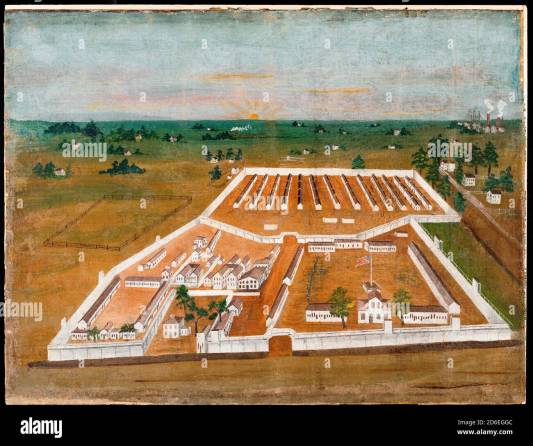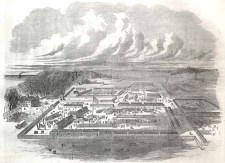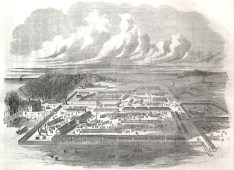
The hell hole of Camp Sumter Military Prison, commonly known as Andersonville in Georgia, is well known by Civil War enthusiasts. Its commandant, Captain Henry Wirz, was tried and hanged for the abuses he allowed to be committed. The Confederate prisoner of war camps could be horrible places of desperate living, but the South was not the only place of POW hell. The North also had areas of terrible detention, and one of the worst was Camp Douglas, located in the Chicago metropolitan area.
Its Origins
 It was initially a training camp. Lincoln’s call for 75,000 3 – year volunteers created a swell of men to enter the ranks. Stephen A. Douglas, senator from Illinois, donated property on the south side of Chicago for the training camp, and the facility was named after him. Troops were trained there, and there was no indication that it would ever be used as anything but a temporary site. That all changed in February 1862.
It was initially a training camp. Lincoln’s call for 75,000 3 – year volunteers created a swell of men to enter the ranks. Stephen A. Douglas, senator from Illinois, donated property on the south side of Chicago for the training camp, and the facility was named after him. Troops were trained there, and there was no indication that it would ever be used as anything but a temporary site. That all changed in February 1862.
The Fort Donelson Prisoners
The Battle of Fort Donelson was a significant victory for the Union. Ulysses S. Grant gained a reputation there, and he also acquired custody of 12-15,000 Confederate soldiers. Because of Chicago’s status as a transportation hub, it was selected as a place for the incarceration of Confederate prisoners. Camp Douglas was close to the Illinois Central Railroad, and the Federal government used that rail line to transport the prisoners north. It would remain a prison camp for the rest of the war.
there, and he also acquired custody of 12-15,000 Confederate soldiers. Because of Chicago’s status as a transportation hub, it was selected as a place for the incarceration of Confederate prisoners. Camp Douglas was close to the Illinois Central Railroad, and the Federal government used that rail line to transport the prisoners north. It would remain a prison camp for the rest of the war.
80 Acres of Hell
Camp Douglas received an initial shipment of 3200 prisoners on February 21, 1862. The grounds of Camp Douglas could barely accommodate more than 6000 prisoners, and the ranks of Confederate POWs were about to swell significantly. Camp Douglas had its largest number of Confederate prisoners of war in December 1863 and had its second-largest group of prisoners in February 1865.
 Camp Douglas had four distinct areas. The camp headquarters was located in Garrison Square and occupied a 20-acre area. The 10-acre White Oak Square had one-story barracks and housed Confederate prisoners of war until Prisoner Square was opened. White Oak Square was where the latrines could be found. Incidentally, those latrines were not much more than shallow trenches. Finally, South Square had the hospital and other support facilities. Prisoner Square contained 36 barracks when it opened in January 1864, and then construction increased that number to 66 barracks by that year’s end.
Camp Douglas had four distinct areas. The camp headquarters was located in Garrison Square and occupied a 20-acre area. The 10-acre White Oak Square had one-story barracks and housed Confederate prisoners of war until Prisoner Square was opened. White Oak Square was where the latrines could be found. Incidentally, those latrines were not much more than shallow trenches. Finally, South Square had the hospital and other support facilities. Prisoner Square contained 36 barracks when it opened in January 1864, and then construction increased that number to 66 barracks by that year’s end.
Major prisoner exchanges in 1862 and1863 reduced the size of the population, but those exchanges ended in August 1863.The sanitary system of Camp Douglas was insufficient to deal with the numbers. The problem was compounded by a small supply of blankets, awful food, and a discipline regimen that was often arbitrary. Dysentery and diarrhea were the primary causes of death. It is estimated that somewhere between 5000 and 6000 prisoners of Camp Douglas died while it was in operation.
A Tourist Attraction
People in the 19th century had different sensitivities than modern folks. What we may think of as horrible, they didn’t seem to mind doing. There was little personal privacy within the prison, which was exacerbated by what the good people of Chicago did at that time.
The citizens of the Windy City had free access to the camp in the early days. They were curious to see what real Confederate soldiers looked like and accessed the grounds without any problem. It was even possible for a prisoner to escape by acting as a member of the visitor’s family. Security got tighter as the war progressed.
One enterprising businessman found a way to make some money. He erected a viewing platform at the hotel across the street from Camp Douglas. Customers could view the inside of the camp and its residents for a fee of ten cents. The viewing was not limited to adults. Children got a chance to look at the half-starved inmates from the viewing platform and may have watched a few collapse from fever.
hotel across the street from Camp Douglas. Customers could view the inside of the camp and its residents for a fee of ten cents. The viewing was not limited to adults. Children got a chance to look at the half-starved inmates from the viewing platform and may have watched a few collapse from fever.
The Aftermath
The war finally ended, and nobody wanted a memorial of the conflict on what was prime urban property. The surviving prisoners of Camp Douglas received some clothing and a one-way train ticket out of town. Once it was deserted, Camp Douglas was burned to the ground, and any remaining equipment was sold as a surplus. The parade ground would be later used as a baseball field.
People conveniently forgot that there was a prisoner of war camp in Chicago until a memorial was finally erected at the Oak Woods Cemetery, where possibly 4000 Confederate soldiers who died at Camp Douglas were interred. The monument was met with hostility partly because African Americans now populated the neighborhood where Camp Douglas once stood. They resented any memorial to Confederate soldiers. There is now a Camp Douglas Restoration Foundation that seeks to preserve information about Camp Douglas and other facts about the Civil War that are related to Chicago.
Final Thoughts
The National Park Service preserves many Civil War prisons, including Fort Monroe, where Jefferson Davis was incarcerated.
An interesting side note about who could be considered prisoners of war by the North is found in Article 50 of the Lieber Code. Those who accompanied Confederate Army, including newspaper reporters, could be made prisoners of war and treated that way if captured by Union soldiers. Foreign civilians could also be prisoners of war if caught. Exemptions were given to chaplains and medicals under article 53.
